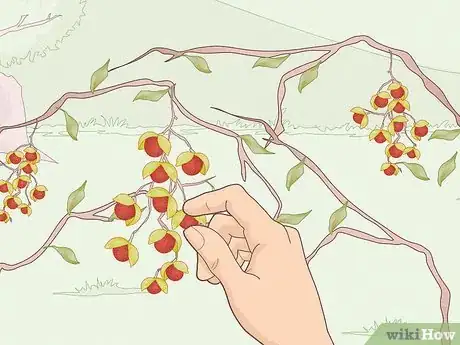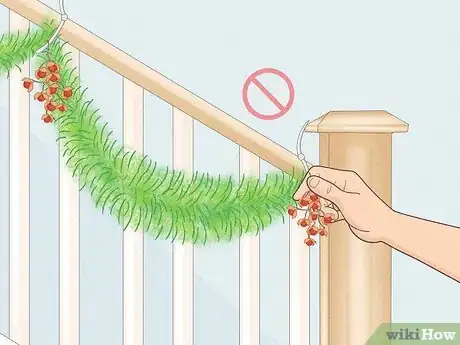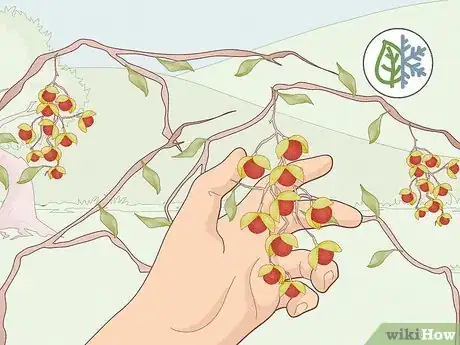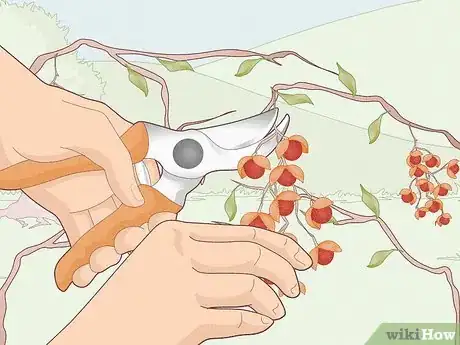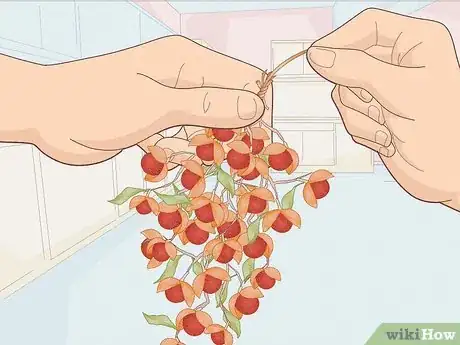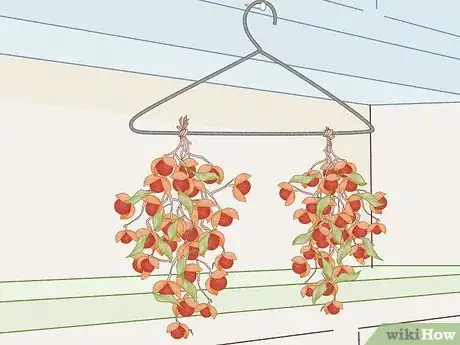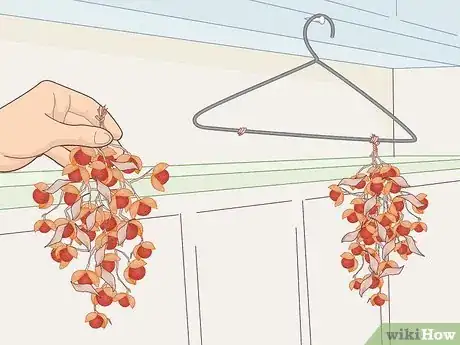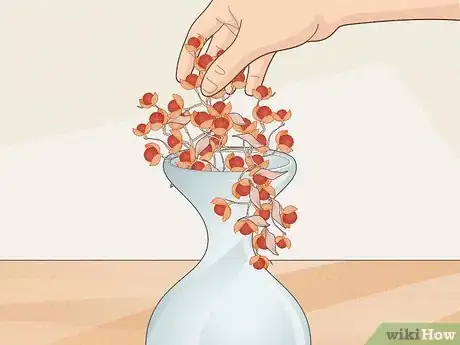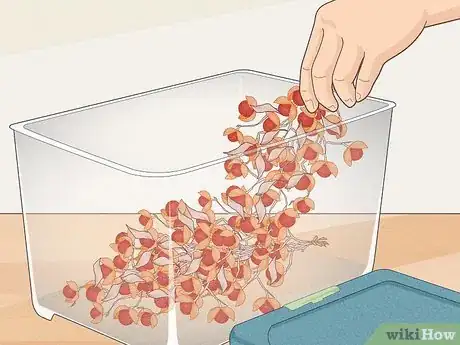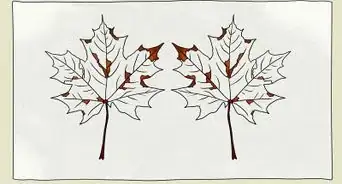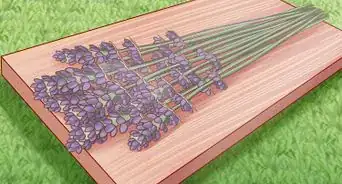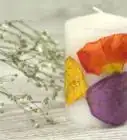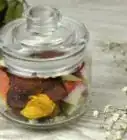This article was co-authored by wikiHow staff writer, Jessica Gibson. Jessica Gibson is a Writer and Editor who's been with wikiHow since 2014. After completing a year of art studies at the Emily Carr University in Vancouver, she graduated from Columbia College with a BA in History. Jessica also completed an MA in History from The University of Oregon in 2013.
There are 9 references cited in this article, which can be found at the bottom of the page.
This article has been viewed 14,547 times.
Learn more...
Add a pop of color to your fall decorations with American bittersweet. Find this vine-like plant in woodlands or forests and clip a few pieces so you can display its red berries in your home. The bright red berries look great in vases with colorful oak leaves, pinecones, or holly, for instance. Since bittersweet dries easily on its own and the berries don't fall off, you can keep the decorations for years to come!
Steps
Harvesting Bittersweet
-
1Identify American bittersweet vines by the flowers at their tips. The leaves on the vines are pointed and the clustered flowers are yellow-green. In fall, the papery flowers fall away and you'll see red berries. The leaves also turn pale yellow and dry up in the fall.[1]
- Check local forests and woodlands for American bittersweet vines. These may cover the ground or wrap around trees.
-
2Do not use Oriental bittersweet vines in any crafts or projects. Although it's easy to mistake this plant for American bittersweet, it's an invasive species that's hard to control. Oriental bittersweet flowers are smaller and spread across the entire vine. The berries fall off when they dry, which is another reason to avoid it for decorative projects.[2]
- If you accidentally bring Oriental bittersweet vines home, throw them in the trash instead of tossing them in the yard or in your compost.
Advertisement -
3Harvest the bittersweet around the first freeze in late fall. Wait until the weather turns colder and you see red berries on the vines before you cut them. Check your area's first freeze date and clip the bittersweet around that time. If you cut the vine too early, the berries may not develop enough to turn red.[3]
Did You Know? American bittersweet goes dormant in the winter, but it will grow blooms on the new growth that it puts on in the spring. Cutting back the flowering vines actually encourages the plant to grow new blossoms.
-
4Clip thin American bittersweet vines with garden shears. Once you've identified American bittersweet vines, take clean gardening shears or clippers and cut a vine. Choose vines that are thinner than a pencil if you plan on shaping them. Cut pieces of the vine as long as you'd like and remember to include the flowering tips.[4]
- Cut short pieces if you'll be sticking them into flower vases or clip longer pieces if you plan on twisting them into a wreath.
Drying American Bittersweet
-
1Gather the bittersweet pieces together and tie them at the cut end. To dry a handful of bittersweet vines, bunch them together at the ends that don't have the berries. Then, wrap a piece of twine or a rubber band around the end to secure the pieces.[5]
- If you're only drying a few pieces of bittersweet, there's no need to wrap them together. Simply lay them flat in a dry place.
- To dry a lot of bittersweet pieces, make lots of small bundles instead of a single, large one.
Tip: If you're going to make a wreath with the vines, twist them around the wreath's wire before you dry the vines. It's easier to make the wreath while the vines are flexible.
-
2Hang the bittersweet in a dry indoor space out of direct sunlight. Choose a drying area and hang the gathered end of the bittersweet vine from a hook for at least a few days. If you don't have a hook, use a clip to attach the bittersweet to a hanger. Then, hang it in your closet or pantry, for instance.[6]
- It's important to keep the bittersweet out of direct sunlight so the berries don't fade as they dry.
-
3Take the bittersweet down once the leaves are dry. Leave the pieces hanging until the leaves dry and fall off. More of the berries will also open up as the vine dries. The amount of time it takes the bittersweet to dry depends on how fresh the vine was when you cut it.[7]
- If the vine and berries feel dry but there are still leaves on the vine, pluck the leaves off with your hands.
-
4Use the dried bittersweet in wreaths and indoor decorations during the fall. Once the bittersweet berries look dry, take them down and remove the rubber band or twine. Stick pieces of the bittersweet into wreaths, arrange them in vases with other fall plants, or spread them across your mantle for beautiful fall decorations.[8]
- Bittersweet looks beautiful with colorful oak leaves, wheat sheaths, and pinecones.
-
5Store the dried bittersweet in a storage container for up to several years. Since the red berries don't fall off like Oriental bittersweet, you can keep the bittersweet for years. Place the pieces into a storage container that will protect the berries from being crushed or broken. Store the container out of direct sunlight until you're ready to use the decorations again.[9]
- Replace the dried bittersweet when you feel like the pieces are looking too fragile. Eventually, the berries will shrivel and they may even fade.
Warnings
- Since Oriental bittersweet is an invasive species, it's against the law in many states to remove the vines or berries. Avoid using Oriental bittersweet in your decorations or you may spread the plant.[10]⧼thumbs_response⧽
- Avoid eating the red berries. Although it's safe for birds to eat them, they're toxic for humans.[11]⧼thumbs_response⧽
References
- ↑ https://www.fs.usda.gov/Internet/FSE_DOCUMENTS/fsbdev3_017307.pdf
- ↑ https://www.fs.usda.gov/Internet/FSE_DOCUMENTS/fsbdev3_017307.pdf
- ↑ https://youtu.be/K5vjWCoY6LQ?t=241
- ↑ https://dengarden.com/gardening/How-to-Grow-American-Bittersweet-for-Winter-Interest
- ↑ https://youtu.be/oHbb4wFqm64?t=65
- ↑ https://www.thriftyfun.com/Growing-Bittersweet-1.html
- ↑ https://www.thriftyfun.com/Growing-Bittersweet-1.html
- ↑ https://www.sungazette.com/news/outdoors/2019/11/using-nature-to-celebrate-the-season/
- ↑ https://gardening.yardener.com/Using-Bittersweet
